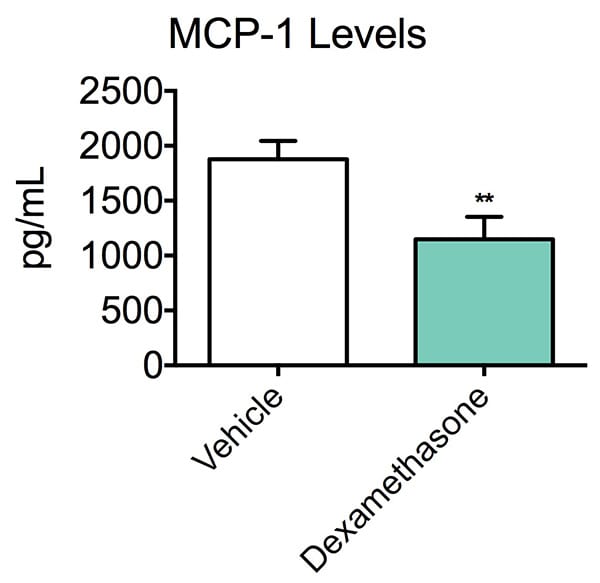Monocyte Infiltration
Discover how Melior’s unique phenotypic screening platforms can uncover the untapped value of your candidate therapeutic
Peritonitis can be triggered by a number of causes, such as infection, but invariably is associated with infiltration of an array of leukocytes into the peritoneal cavity. In turn, the trafficking of leukocytes is mediated by a number of cytokines. This is easily modelled in rodents.
Thioglycollate-mediated leukocyte recruitment and cytokine production in the peritoneum can be utilized as a model of inflammation, acute peritonitis and leukocyte/monocyte migration.
The inflammatory response generated in this model can be attenuated by administration of a number of known anti-inflammatory agents. In this study, we utilized Dexamethasone treatment to test for effects on thioglycollate-stimulated production of peritoneal monocyte chemoattractant protein-1 (MCP-1).
Ready to get started or looking for a custom model?
Contact us today for more information about our bespoke research models and to discuss how we can help you answer your unique research questions.

Administration of thioglycollate produced a dramatic increase in the levels of MCP-1 in vehicle-treated mice compared to untreated animals. Treatment with dexamethasone, a potent corticosteroid, significantly reduced the levels of MCP-1 relative to vehicle treatment.
This effect of dexamethasone is consistent with its anti-inflammatory activities and reported effects of compounds that reduce peritonitis in thioglycollate models (Segal et al., 2002). Data represent mean concentrations ± SEM; **p<0.01 (compared to vehicle) (N=18).
Dexamethasone was able to significantly reduce the levels of MCP-1 in the peritoneal cavity after thioglycollate administration. The reduction of MCP-1 levels is a reliable surrogate for the reduction in monocyte infiltration. This model stands as a good predictor of peritonitis therapeutic candidates. As a screen, it can point the way for further studies of promising compounds, by viewing relative levels of the cytokine MCP-1. Cell counts of different leukocytes and measurement of different cytokines can also be incorporated into this model.
This model is typically run in an acute setting, performed in a single day with a single administration of test article. As a model of peritonitis it is similar to the Zymosan A-induced Model of Peritonitis.
